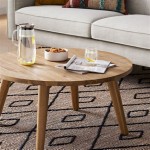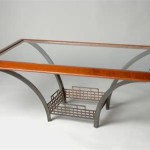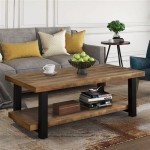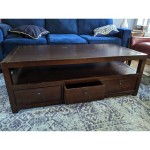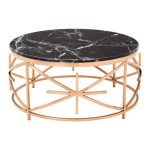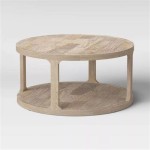Outdoor Faux Concrete Coffee Tables: Durability and Design
Outdoor living spaces have become increasingly important, serving as extensions of the home where relaxation and entertainment take place. Selecting the right furniture for these spaces is crucial, balancing aesthetic appeal with practical considerations such as weather resistance and longevity. Outdoor coffee tables are central to these spaces, providing a surface for beverages, snacks, and décor. Faux concrete coffee tables have emerged as a popular choice, offering the industrial-chic look of concrete without the associated weight and maintenance concerns. This article examines the features, benefits, and considerations associated with selecting an outdoor faux concrete coffee table.
Understanding Faux Concrete Materials
The term "faux concrete" refers to materials that mimic the visual appearance and texture of concrete but are not composed of traditional cement-based mixtures. Several materials are employed to achieve this effect, each with varying properties and advantages. Common materials include: * Fiberglass Reinforced Concrete (GFRC): This material combines concrete with glass fibers, resulting in a lighter and more durable product than traditional concrete. GFRC is highly customizable and can be molded into various shapes and sizes, making it suitable for intricate designs. * Resin-based Composites: These materials use resin as a binder, often combined with aggregates such as stone or sand to create a concrete-like texture. Resin-based composites are typically lighter than GFRC and offer excellent water resistance. * Polymer Concrete: This material uses polymers instead of cement as a binder, resulting in a product that is highly resistant to chemical attack and freeze-thaw cycles. Polymer concrete is often used in industrial applications but is also suitable for outdoor furniture due to its durability. * Wood or Metal Frames with Concrete Overlay: In some cases, faux concrete coffee tables may feature a wood or metal frame covered with a thin layer of concrete or a concrete-like coating. This approach offers a combination of strength and aesthetic appeal. The specific material used in a faux concrete coffee table significantly impacts its weight, durability, and resistance to the elements. Understanding the composition of the material is essential when evaluating different options.
Advantages of Choosing a Faux Concrete Coffee Table
Faux concrete coffee tables offer several benefits over traditional concrete or other materials, making them a compelling choice for outdoor spaces. These advantages include:
Reduced Weight: One of the most significant advantages of faux concrete is its lighter weight compared to solid concrete. This makes the tables easier to move and reposition, facilitating arrangement changes and seasonal storage. Traditional concrete tables can be extremely heavy, requiring multiple people or specialized equipment for relocation, which can be a significant drawback for homeowners.
Enhanced Durability: Faux concrete materials are often engineered to be more durable than traditional concrete, particularly in outdoor environments. They are typically more resistant to cracking, chipping, and fading. Materials such as GFRC and polymer concrete offer superior resistance to freeze-thaw cycles, which can cause significant damage to traditional concrete. The enhanced durability translates to a longer lifespan for the coffee table, reducing the need for frequent replacement.
Improved Weather Resistance: Outdoor furniture is constantly exposed to the elements, including rain, sun, and temperature fluctuations. Faux concrete materials are designed to withstand these conditions. Resin-based composites and polymer concrete are inherently water-resistant, preventing moisture absorption and subsequent damage. UV inhibitors are often added to the materials to protect against fading and discoloration caused by prolonged sun exposure. This weather resistance ensures that the coffee table maintains its appearance and structural integrity over time.
Design Versatility: Faux concrete materials can be molded into a wide range of shapes and sizes, offering greater design versatility compared to traditional concrete. This allows for more intricate and aesthetically pleasing designs, including rounded edges, complex patterns, and custom finishes. Faux concrete can also be textured to mimic the look and feel of various types of concrete, from smooth and polished to rough and weathered. This design flexibility allows homeowners to select a coffee table that perfectly complements their outdoor décor.
Lower Maintenance: Faux concrete coffee tables typically require less maintenance than traditional concrete tables. They are less porous, making them easier to clean and less susceptible to staining. Sealing is generally not required, further reducing maintenance efforts. Regular cleaning with mild soap and water is usually sufficient to keep the table looking its best. This low maintenance requirement makes faux concrete a practical choice for busy homeowners who want to enjoy their outdoor spaces without spending excessive time on upkeep.
Factors to Consider When Selecting a Faux Concrete Coffee Table
When choosing an outdoor faux concrete coffee table, several factors should be carefully considered to ensure that the selected table meets the specific needs and preferences of the buyer. These factors include:
Material Composition: As previously mentioned, different faux concrete materials offer varying properties. It is essential to understand the composition of the material used in the coffee table and its implications for durability, weather resistance, and maintenance. For example, if the table will be exposed to harsh winter conditions, a material with high freeze-thaw resistance, such as polymer concrete, may be the best choice. The product description should clearly state the material used.
Size and Shape: The size and shape of the coffee table should be appropriate for the size and layout of the outdoor space. A large coffee table may overwhelm a small patio, while a small coffee table may be insufficient for a large seating area. Consider the number of people who will typically be using the table and the types of activities that will take place. Round coffee tables can be a good choice for smaller spaces, while rectangular or square tables may be more suitable for larger seating arrangements. Consider the height of the table relative to the seating around it.
Design and Style: Faux concrete coffee tables are available in a wide range of designs and styles, from minimalist and modern to rustic and industrial. Choose a design that complements the existing outdoor décor and reflects the homeowner's personal style. Consider the color and texture of the faux concrete, as well as any additional features, such as metal accents or built-in storage. The design should be both aesthetically pleasing and functional.
Weight and Stability: While faux concrete is generally lighter than traditional concrete, the weight of the coffee table should still be considered. A heavier table may be more stable and less likely to be blown over by wind, but it will also be more difficult to move. Ensure that the table is stable and well-balanced, particularly if it will be used on uneven surfaces. The base of the table should be wide enough to provide adequate support.
Price and Warranty: Faux concrete coffee tables vary in price depending on the material, size, design, and manufacturer. Set a budget and compare prices from different retailers to find the best value. Consider the warranty offered by the manufacturer, as this can provide protection against defects in materials or workmanship. A longer warranty typically indicates a higher level of confidence in the product's quality and durability.
Maintenance Requirements: While faux concrete is generally low-maintenance, it is still important to understand the specific care requirements for the chosen material. Ask the retailer or manufacturer for recommendations on cleaning products and techniques. Avoid using harsh chemicals or abrasive cleaners, as these can damage the surface of the table. Regularly inspect the table for any signs of damage or wear and tear, and address any issues promptly to prevent further deterioration.
Environmental Considerations: For environmentally conscious consumers, consider the sustainability of the faux concrete material. Some materials are made from recycled content or are manufactured using eco-friendly processes. Look for certifications or labels that indicate a commitment to sustainability. Choosing a durable and long-lasting coffee table can also contribute to environmental responsibility by reducing the need for frequent replacement.
By carefully considering these factors, homeowners can select an outdoor faux concrete coffee table that is both aesthetically pleasing and functionally suited to their needs, providing a durable and stylish addition to their outdoor living space.

Diy Faux Concrete Coffee Table With Spray Paint Savvy Apron

Pomona Concrete Acacia Round Outdoor Coffee Table 38

Diy Concrete Outdoor Coffee Table The Honest Home

Bolinas Concrete Round Outdoor Coffee Table 36 Pottery Barn

Safavieh Round Indoor Outdoor Concrete Coffee Table

Diy Concrete Outdoor Coffee Table The Honest Home

Diy Concrete Outdoor Coffee Table Love Renovations

Diy Concrete Outdoor Coffee Table Love Renovations

Concrete Pedestal Outdoor Round Coffee Table Durable Design West Elm

Campos Coffee Table Artwood
